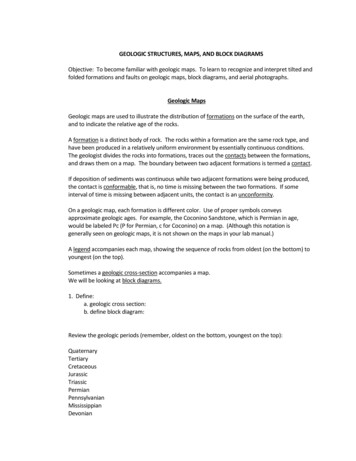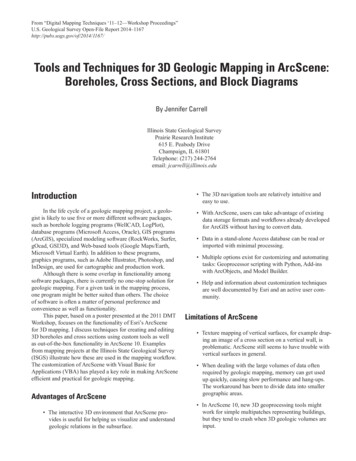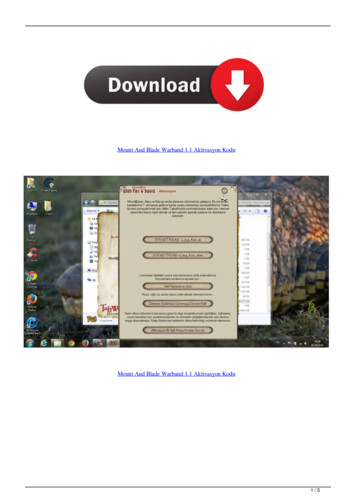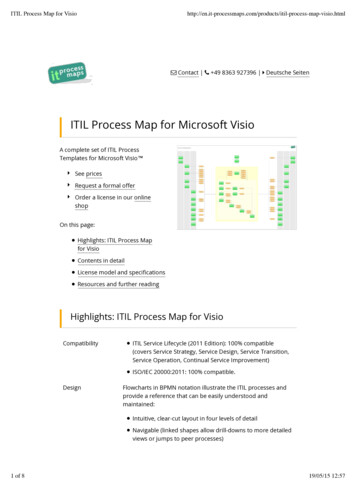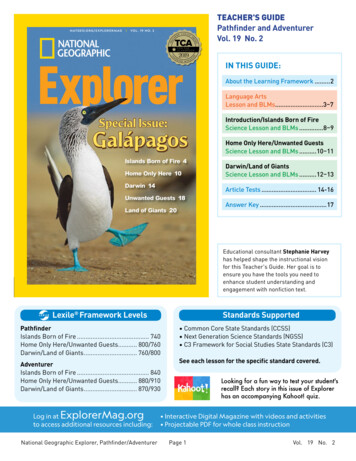
Transcription
Geologic Map of the Mount Baker 30- by 60-Minute Quadrangle,WashingtonBy R.W. Tabor, R.A. Haugerud, Wes Hildreth, and E.H. BrownPrepared in cooperation with the Washington State Departmentof Natural Resources, Division of Geology and Earth ResourcesPamphlet to accompanyGeologic Investigations Series I–26602003U.S. Department of the InteriorU.S. Geological Survey
Geologic Map of the Mount Baker 30- by 60-Minute Quadrangle, WashingtonBy R.W. Tabor1, R.A. Haugerud2, Wes Hildreth1, and E.H. Brown3INTRODUCTIONarea: lithologic, time-stratigraphic, structural, andstratigraphic-structural (terranes). The plethora of terms isconfusing to everyone, but the complexity of the geologyallows little simplification. Much of the crust in northwestWashington appears to be built of accreted terranes, hencemany units have been given terrane names in the past (seeTabor and others, 1987a,b, 1989; Brandon, 1989). On thismap, even though most pre-Tertiary units are terranes orprobable terranes, where possible, we have used establishedlithologic or time-stratigraphic names. In discussion, wecommonly move up the nomenclatural ladder to a more comprehensive terrane name. Within the main text describingeach unit or group of units, we discuss the use of the appropriate names. Names used in the General Geology overviewderive from the more lengthy discussion.The Mount Baker 30- by 60-minute quadrangle encompasses rocks and structures that represent the essence of thegeology of the North Cascade Range (fig. 1, sheet 2; fig. 2, sheet1). The quadrangle is mostly rugged and remote and includesmuch of the North Cascade National Park and several dedicated wilderness areas managed by the U.S. Forest Service.Geologic exploration has been slow and difficult. In 1858George Gibbs (1874) ascended the Skagit River part way tobegin the geographic and geologic exploration of the NorthCascades. In 1901, Reginald Daly (1912) surveyed the 49thparallel along the Canadian side of the border, and GeorgeSmith and Frank Calkins (1904) surveyed the United States’side. Daly’s exhaustive report was the first attempt to synthesize what has become an extremely complicated geologic story.Modern geologic work began almost a half a centurylater when, in 1948, Peter Misch began his intensive studyof the North Cascade Range (Misch, 1952, 1966, and seeother references). His insights set the stage for all later workin the North Cascades. Considerable progress in understanding the North Cascades in light of modern plate tectonic theoryhas been made by E.H. Brown and his students. We have usedmuch of their detailed geologic mapping (fig. 3, sheet 2).Although our tectonic reference frame has changed muchwith the recognition of plate tectonics and exotic terranes,Misch’s observations prove to be remarkably accurate.Our work in the Mount Baker quadrangle began in 1983as part of a project to map and compile the geology of theWenatchee and Concrete 1 by 2 quadrangles at 1:100,000scale (fig. 1), work that we began in 1975. We have mapped incooperation with the Division of Geology and Earth Resources,Washington State Department of Natural Resources. We havealso benefited by the cooperation and helpfulness of theNational Park Service and the U.S. Forest Service.ACKNOWLEDGMENTSMany people have helped with field work in the difficult terrane of the Mount Baker quadrangle: Michael Ort(1984–1985), Patrick Goldstrand (1985), CarolynOrtenburger (1985–1986), Janet Slate and Robert Fillmore(1986), Kathleen Duggan (1987–1988), Scott Spees (1987),Eric Roth (1988), Kris Alvarez (1990–1991), Tom Grundy(1990), Carmello Ferlito, David Maher, and JimMontgomery (1991), Chad Nelsen, Cathryn Dwyre, and RobOsborn (1992). Hildreth began investigating the Quaternaryvolcanic rocks in 1992; for field assistance he is grateful toKari Cooper, Mike Dean, Judy Fierstein, Ellen Lougee, DaveTucker, and Patricia Weston. Many employees of NorthCascades National Park and the Mount Baker Ranger Districtof the U.S. Forest Service have been helpful, in particularCraig Holmquist, Kevin Kennedy, Jerry Lee, and Bill Lester;Jon Reidel has been particularly helpful. We are thankfulthat superb and ultimately cooperative helicopter pilots andtheir crews exist; thank you Tony and Sue Reese for oursuccess and our safety.We have discussed the geology of the map area withmany. In particular we have enjoyed extended and sometimes heated discussions with Derick Booth, Mark Brandon,Darrel Cowan, Joe Dragovich, Bob Miller, the late PeterMisch, Jim Monger, John Reidel, John Stacy, Jeff Tepper,and Joe Vance. Darrel Cowan, Derick Booth, and Bob Millermade many helpful suggestions for improvement of mapand text.THE PROBLEM OF NAMESPrevious workers, including the present authors, haveapplied four kinds of names to geologic units in the map1U.S.Geological Survey, Menlo Park, California 94025U.S.Geological Survey, University of Washington, Seattle, Washington 981953Department of Geology, Western Washington University, Bellingham,Washington 9822521
R.W. Tabor produced this digital map with GIS technology using Alacarte (Wentworth and Fitzgibbon, 1991).Many computer and (or) GIS experts helped, especiallyTracey Felger, Todd Fitzgibbon, Patricia Helton, EricLehmer, Bob Mark, Chad Nelson, Geoff Phelps, and PahdyMcCarthy. Many thanks to Carl Wentworth, who, no matterhow busy, always answered questions about Alacarte.suggested that the Ross Lake Fault Zone is a minor dislocation in an essentially uninterrupted cross section of aMesozoic arc ranging from the deep roots in the NorthCascade core to the unmetamorphosed marine and terrestrialfore-arc deposits of the Methow terrane to the east.GENERAL GEOLOGYRocks west of the Straight Creek Fault:the Northwest Cascades SystemRocks in the Mount Baker quadrangle represent almostall the geologic events recorded in the entire North Cascades:(1) pre-mid-Cretaceous assembly of Mesozoic and Paleozoicterranes that have different paleogeographic origins andstructural and metamorphic histories (Tabor and others,1989; Tabor 1994), (2) mid-Cretaceous to Late Cretaceousthickening by thrusting and pluton accumulation (Misch,1966; McGroder, 1991; Brown and Walker, 1993; Haugerudand others, 1994), accompanied and followed by regionalmetamorphism, (3) Eocene strike-slip faulting, extensionalfaulting, basin development, and continued metamorphismand plutonism (Johnson, 1984, 1985; Brown, 1987; Millerand Bowring, 1990; Haugerud and others, 1991; Miller,1994), (4) growth of the Cascade magmatic arc in Oligoceneto Holocene time (Vance and others, 1986, 1987; Smith,1993; Tabor and others, 1989), and (5) Quaternary glacialerosion, drainage derangement, and deposition of glacialderived sediments (Booth, 1987, 1990).We summarize this geology here. More detailed discussions of bedrock lithologies, young volcanic rocks ofKulshan Caldera and Mount Baker volcanic center, unconsolidated deposits and Quaternary history, complete withmore detailed references, follow.The Straight Creek Fault and the Ross Lake Fault Zonedivide the rocks of the quadrangle into a core of deep-seated,thoroughly metamorphosed rocks, flanked by less metamorphosed rocks on either side (fig. 1, sheet 2; fig. 2, sheet 1).These major faults are thought to be predominantly strikeslip (Misch, 1977a; Vance and Miller, 1981, 1992; Miller,1994), though the rocks of the metamorphic core have beenuplifted 15 to 25 km relative to rocks on either side. TheStraight Creek Fault, although now predominantly obliterated by Tertiary arc plutons, almost bisects the quadrangle.It separates core rocks on the east from the NorthwestCascades System on the west. Estimates of right-lateral strikeslip on the Straight Creek Fault range from about 90 to 190km (Vance and Miller, 1981, 1992; Vance, 1985; Mongerin Price and others, 1985; Kleinspehn, 1985; Colemanand Parrish, 1991; McGroder, 1991). Miller and Bowring(1990) described structural evidence of an early episodeof strike slip on the Ross Lake Fault, and Haugerud (1985)and Miller and others (1994) indicated a strong discontinuity in metamorphic grade and history across the zone.Kriens (1988) and Kriens and Wernicke (1990a,b)West of the Straight Creek Fault, the North Cascadesappear to be composed of two fundamental regional structuralblocks separated by a complex tectonic belt and high-anglefaults (fig. 1, sheet 2; fig. 4, sheet 1; see also Tabor and others,1989; Tabor, 1994; Tabor and Haugerud, 1999). The northeastern structural block, exposed primarily in the Mount Bakerquadrangle, is mostly composed of Paleozoic and Mesozoicvolcanic arc and associated clastic wedge deposits along withmore thoroughly metamorphosed oceanic rocks, thrust in themid-Cretaceous into a series of nappes. The overall structurehas been likened to a regional mélange by Brown (1987)who, modifying the earlier terminology of Misch (1966, p.128), called rocks of this structural block the NorthwestCascade System. As explained below, we now think that thestructure displays more order than regional mélange implies.The southwestern block, exposed just south of the MountBaker quadrangle, is mostly Mesozoic clastic rocks ofsubmarine-fan origin and relatively unmetamorphosedoceanic rocks. Tabor and others (1989, 1993, 2002), Frizzelland others (1987), and Tabor (1994) described this block asthe western and eastern mélange belts.Four major nappes, stacked along folded thrusts, andtheir probably autochthonous footwall make up the Northwest Cascades System (fig. 4, sheet 1; fig. 5, sheet 2). Thestructural stratigraphy of the Northwest Cascades Systemappears to be consistent over a wide area of northwestWashington. The rocks in the three lowermost nappes andthe autochthon differ enough in lithology, structure, andmetamorphic history to warrant consideration as separateterranes (Tabor and others, 1989; Haugerud and others,1994), but the highest and youngest Gold Run Pass Nappeconsists of slices of the lower nappes and autochthon.The stacked nappes have been displaced by extensionalfaults. The Glacier Extensional Fault is a regional structurethat cuts out the nappe stratigraphy along the west side ofthe Mount Baker quadrangle.PRE-MID-CRETACEOUS ROCKSRocks of the autochthonNooksack Formation (new name adopted here)At the bottom of the exposed stack of nappes is theMiddle Jurassic–Early Cretaceous Nooksack Formation consisting of marine clastic rocks overlying and interfingering2
stratigraphically with the Middle Jurassic Wells Creek VolcanicMember (newly adopted herein). Sondergaard (1979) considered the rocks of the Nooksack Formation to be a submarinefan deposit associated with a volcanic arc. The Nooksack isgenerally not strongly penetratively deformed and recrystallized, although in many areas it has slaty cleavage and has beenpartially recrystallized in sub-greenschist facies.or associated with the Elbow Lake Formation are ultramafic rocks, various blocks of gneiss and schist, andgranitoid rocks ranging from granite to gabbro in composition. These are locally mapped as the Twin SistersDunite of Ragan (1963), the blueschist of Baker Lake,the Vedder Complex of Armstrong and others (1983), andthe Yellow Aster Complex of Misch (1966). Ages ofradiolarians from chert blocks in the Elbow LakeFormation range from Pennsylvanian to Jurassic. Gneissand schist of the Vedder Complex yield K-Ar and Rb-Srages indicating Permian metamorphism. Zircons fromYellow Aster paragneiss have discordant U-Pb agesinterpreted to be Precambrian and probably representingdetritus derived from Proterozoic basement. Zircons fromorthogneiss in the complex yield middle Paleozoic ages.These rocks make up the Welker Peak Nappe (figs. 4, 5).In part, the Bell Pass mélange is coincident physicallyand in concept with the thick tectonic zone at the base ofthe mid-Cretaceous Shuksan Thrust Fault as describedby Misch (1966, 1980), which separates more thoroughlymetamorphosed rocks of the Easton Metamorphic Suite—equivalent to Misch’s (1966) Shuksan MetamorphicSuite—from the structurally underlying NooksackFormation, Chilliwack Group, and Cultus Formation.However, we suspect that some of the mixing anddeformation within the Bell Pass mélange predates midCretaceous tectonism and is unrelated to the Shuksan ThrustFault (see description of the Bell Pass mélange below).Excelsior and Welker Peak NappesChilliwack Group of Cairnes (1944) andCultus Formation of Brown and others (1987)Structurally overlying the Nooksack Formation alongthe Excelsior Ridge Thrust Fault (the Church Mountain thrustof Misch, 1966; see table 1) is the Chilliwack Group ofCairnes (1944), composed of partly metamorphosed basalticand andesitic volcanic rocks, sandstone, siltstone, shale, andminor limestone. The rocks of the Chilliwack formed in anarc setting, and marble in the unit yields fossils ranging inage from Silurian(?) and Devonian to Permian, though mostare Mississippian. Rocks are slaty to phyllitic, and planarstructures are commonly low angle. Lawsonite and aragonite are common metamorphic minerals but generally arevery fine grained. The Chilliwack is depositionally overlainby the Cultus Formation of Brown and others (1987), aTriassic to Early Jurassic marine and dacitic volcanic unit.The Chilliwack Group and Cultus Formation occur mainlyin the Excelsior Nappe (fig. 5, sheet 2). The Excelsior Nappecontains significant internal thrusts; rocks of the ChilliwackGroup and Cultus Formation are regionally overturned, andthey have penetrative fabrics in most locales, suggesting apre-mid-Cretaceous, possible pre-Late Jurassic tectonic eventnot seen in the underlying Nooksack Formation.A unit with similarities to the clastic facies of theChilliwack Group, as well as other units in the NorthwestCascade System, is the slate of Rinker Ridge. It is poorlyexposed in the lower Skagit River valley of the Mount Bakerquadrangle. Good exposures in the Sauk River quadrangleto the south (fig. 1; Tabor and others, 2002) indicate that theslate of Rinker Ridge appears to be a fault-bounded blockwithin extensive outcrops of the Easton Metamorphic Suite.Tabor and others (2002) discuss the possible protoliths forthe slate of Rinker Ridge and tentatively assign it to theChilliwack Group. We include it in the Excelsior Nappe infigure 4. Dragovich and others (2002) consider the slate ofRinker Ridge to be Darrington Phyllite.Shuksan NappeEaston Metamorphic SuiteThe Easton Metamorphic Suite, also referred to theEaston terrane (Tabor and others, 1989), is composed ofthe Shuksan Greenschist and the Darrington Phyllite. Itgenerally overlies lower nappes along the Shuksan ThrustFault. The Easton records a more thorough episode ofhigh P/T metamorphism than the other units in theNorthwest Cascades System.The well-recrystallized Shuksan Greenschist andDarrington Phyllite were metamorphosed in blueschistfacies, with blue amphibole and lawsonite in rocks ofappropriate composition. Chemical composition of mostShuksan Greenschist indicates it was derived from midocean ridge basalt (MORB). Based on isotopic analyses,Armstrong (1980) and Brown and others (1982) interpretthe Easton to have a Middle to Late Jurassic depositionalage (about 150–160 Ma) and an Early Cretaceous metamorphic age (about 120–130 Ma), with evidence for local earliermetamorphism.The semischist and phyllite of Mount Josephine cropsout in extensive tracts along the west side of the Mount Bakerquadrangle and farther west. This unit overlies the Bell Passmélange along a thrust here correlated with the ShuksanBell Pass mélangeThe Chilliwack Group and Cultus Formation areoverlain along the Welker Peak Thrust Fault by the BellPass mélange, much of which is composed of the ElbowLake Formation of Brown and others (1987), a mixedassemblage of foliated sandstone, argillite (phyllite),ribbon chert, basalt, and very rare marble. Commonly in3
Thrust Fault. Rocks of this unit are similar lithologically tothe Darrington Phyllite, but differ in that their protolith wassandier and that they appear less thoroughly recrystallizedthan the Darrington. Previous workers have included thisunit in the Darrington Phyllite. Greenschist and blueschistintercalations are lacking and rare metavolcanic rocks aregreenstone.terrane in Late Cretaceous and earliest Tertiary time. Thesestitching plutons were deformed and partially recrystallizedto orthogneisses, a process that began in the Late Cretaceousand continued into the early Tertiary as shown by EoceneK-Ar ages and fabrics similar to demonstrably Eocene fabrics in the nearby Skagit Gneiss Complex. South of theMount Baker quadrangle, the plutons can be grouped bymineral composition, δ18O content, and some structuralfeatures into two groups, which in general reflect modalcompositions.Within a tonalitic group, the orthogneisses of HaystackCreek and Mount Triumph are lithologically similar toorthogneiss bodies within the Skagit Gneiss Complex (seebelow) which have 60–70 Ma U-Pb zircon ages.Within a granodioritic group, the Eldorado Orthogneisswas intruded at 90 Ma and is strongly deformed and extensively recrystallized; the orthogneiss of Marble Creek wasintruded at about 75 Ma and is extensively deformed andrecrystallized; the Hidden Lake stock, apparently on the edgeof the deep and thoroughly metamorphosed orogen, wasintruded at 75 Ma and is well recrystallized but less deformedthan the tonalitic bodies mentioned above; the orthogneissof Alma Creek is even less deformed and perhaps slightlyyounger.The Skagit Gneiss Complex (Skagit Gneiss of Misch,1966) is banded biotite gneiss, banded amphibolitic gneiss,and large bodies of tonalitic orthogneiss, all mostlymigmatitic. The banded gneisses contain abundantorthogneiss layers on all scales. Small bodies of mafic gneiss,mafic migmatite, ultramafic rock, and marble crop out also.All of the complex is pervaded by concordant to discordantdeformed bodies of light-colored tonalite and tonaliticpegmatite. Based on composition and observed transitionto the protoliths, the banded gneisses appear to be highlymetamorphosed Cascade River and Napeequa Schists. Theorthogneiss of The Needle yields discordant U-Pb zirconages and has textural evidence of multiple deformation, suggesting it is a highly metamorphosed pluton of the LateTriassic Marblemount intrusive episode. Much of the Skagitis permeated by dikes and irregular bodies of granite and,locally, granitic pegmatite which are characterized by aprominent lineation and weak, or absent, foliation; isotopicages of the granites indicate middle Eocene intrusion.Rocks between the Straight Creek Fault andthe Ross Lake Fault ZoneIn the Mount Baker quadrangle, the high-grade metamorphic core of the North Cascades (fig. 1) is made up of the ChelanMountains terrane and plutons that intrude it, as well as theSkagit Gneiss Complex, derived from the supracrustal rocksof the Chelan Mountains terrane by higher-grade metamorphism and pervasive deep-seated intrusion. K-Ar ages of schistsand gneisses in much of the region between the Straight CreekFault and the Ross Lake Fault Zone are almost all middle andlate Eocene, reflecting early Tertiary unroofing and cooling.Much of the core has been intruded by arc-root magmas of theTertiary Chilliwack composite batholith.Chelan Mountains terraneRocks of the Chelan Mountains terrane include theNapeequa Schist, the metaplutonic rocks of theMarblemount-Dumbell belt (fig. 1), and the Cascade RiverSchist. Rocks of the Napeequa Schist are mostly micaceousquartzite, fine-grained hornblende schist, and amphibolitesderived from a protolith of oceanic chert and basalt. Minormarble and small bodies of metamorphosed ultramafic rockare also characteristic.Protolith of the Cascade River Schist was a thicksequence of arc-derived clastic rocks with minor volcanicrocks, now metamorphosed to plagioclase-rich mica schist,metaconglomerate, and amphibolitic schist. Prominent inthe metaconglomerate are clasts of the Marblemount pluton,indicating that the Cascade River protolith was depositedon or near eroded Marblemount pluton. Minor constituentsof the Cascade River Schist are silicic schists (metatuff),marble, and amphibolite. U-Pb analysis of zircons from adacitic metatuff yielded ages of about 220 Ma, that is, LateTriassic.The Marblemount pluton makes up the northern endof the Marblemount-Dumbell plutonic belt whichstretches about 75 km southeast from the Mount Baker quadrangle (fig. 1). The crystallization age of the Marblemountprotolith is also 220 Ma. That the Cascade River Schist andthe Marblemount pluton are the same age suggests deposition of the Cascade River Schist protolith in a forearc orintra-arc basin wherein intrusion of arc-root plutons, suchas the Marblemount pluton, was followed by rapid unroofing and further deposition of arc volcanic rocks.Large amounts of tonalitic to granodioritic magmaintruded the supracrustal rocks of the Chelan MountainsROCKS IN THE ROSS LAKE FAULT ZONERegionally the northwest-trending Ross Lake Fault Zonejuxtaposes the higher-grade North Cascade core rocks witha little-metamorphosed sequence of Mesozoic marine andterrestrial deposits of the Methow terrane to the east (fig. 1).In the Mount Baker quadrangle several faults in the zoneseparate higher-grade metamorphic core rocks from a sliverof lower-grade schist and phyllite—the rocks of Little JackMountain—and a tract of minimally metamorphosed LatePaleozoic and Mesozoic oceanic rocks—the Hozomeen4
Group. For much of their contact, the rocks of the HozomeenGroup overlie the Little Jack terrane along a low-angle thrust,which probably predates the high-angle faults of the RossLake Fault Zone.Within the Ross Lake Fault Zone, a group of plutonsranging from gabbro to granodiorite in composition andintruding rocks of the Little Jack terrane and of the SkymoComplex of Wallace (1976) makes up the Ruby CreekHeterogeneous Plutonic Belt of Misch (1966). Gneissic andmassive plutons suggest a long history of intrusion duringand after deformation in the Ross Lake Fault Zone. The onlyage available from the Ruby Creek belt is middle Eocene(Miller and others, 1989), from a body that on structuralgrounds must be among the youngest components of the belt.The Skymo Complex of Wallace (1976), of unknownprotolith age and terrane affinity, consists of locallyorthopyroxene-bearing mafic to ultramafic cumulate igneous rocks intruded by clinopyroxene gabbro. Hyatt and others(1996), Whitney and others (1996), and Baldwin and others(1997) suggest that the petrologic history of the SkymoComplex is unlike any other unit in the North Cascades. Theunit is faulted against the phyllite and schist of Little JackMountain, in part along low-angle faults. Skymo rocks arealso faulted against orthogneiss of the Skagit Gneiss Complexon the west but are partially engulfed in tonalitic materialassociated with the metamorphism affecting the Skagit, suggesting that the faults separating the two units have had onlymodest displacements since Late Cretaceous metamorphism.ROCKS EAST OF THE ROSS LAKE FAULT ZONEA small area of sandstone and argillite, probably correlative with the Thunder Lake unit (O’Brien, 1986)exposed to the north in British Columbia, crops out onthe east side of the quadrangle. These rocks are in theMethow terrane (fig. 1) and are separated from theHozomeen Group by the Hozomeen Fault.LATE OROGENIC AND POSTOROGENIC DEPOSITSEocene extension associated with strike-slip faultingopened depressions at shallow levels, where fluviatilefeldspathic sandstone and conglomerate accumulated (Taborand others, 1984; Johnson, 1985; Heller and others, 1987),while metamorphism continued in the Skagit GneissComplex. Most of such deposits are preserved outside of theMount Baker quadrangle, but a few remnants crop out in thequadrangle. Sandstone and conglomerate of the EoceneChuckanut Formation crop out along the west side of thequadrangle, in part separated from underlying older rocksby low-angle extensional faults. Smaller patches of probably partly correlative rocks (mapped as older sandstone andconglomerate) are preserved on Mount Despair, near BaconPeak, under and near the volcanic rocks of Big Bosom Buttes,and along the Straight Creek Fault. Younger sandstone andconglomerate crops out along the Straight Creek Fault northof Marblemount where a clast of Marblemount pluton witha zircon fission-track age of 45 Ma shows the deposit to belate middle Eocene or younger.Hozomeen GroupFollowing the example of McTaggart and Thompson(1967) we have, in reconnaissance, roughly subdividedthe Hozomeen Group (newly adopted name) into a lowermost exposed unit of probable upper Paleozoic greenstonewith minor chert and limestone; a middle unit of predominantly Middle and Late Triassic ribbon chert and argillite; and an upper unit of predominantly Late Triassicgreenstone, clastic sedimentary rocks, ribbon chert, andlimestone, with minor Jurassic chert and clastic sedimentary rocks. These three units appear to correlate with theupper three of McTaggart and Thompson’s four units.ROCKS OF THE CENOZOIC CASCADEMAGMATIC ARCThe oldest known Cascade arc rocks in the MountBaker quadrangle are the 34-Ma gabbro of Copper Lakeand the 32-Ma granodiorite of Mount Despair, earlyphases of the Chilliwack composite batholith. The birthof the Cascade magmatic arc was about 36 Ma (Vance andothers, 1987; Smith, 1993). Arc-root plutons of the batholithrange from gabbro to alaskite in composition and from 32 to2.5 Ma (Oligocene to Pliocene) in age. In the quadrangle,plutons of the batholith with ages of about 30 Ma and olderappear to belong to the Index family of arc-root plutons asdefined by Tabor and others (1989). Those in the range ofabout 30 to 20 Ma are in the Snoqualmie family, and thoseyounger than 20 Ma are in the Cascade Pass family.Volcanic rocks of the Cascade magmatic arc aresparse—preserved in scattered down-faulted blocks orcaldera-fill deposits. They commonly were erupted on erodedearly phases of the Chilliwack composite batholith and thenintruded by younger phases. The volcanic rocks of Big BosomButtes, of Mount Rahm, and of Pioneer Ridge range fromdacite to less common andesite and basalt in compositionand are probably Oligocene in age. The Hannegan VolcanicsPhyllite and Schist of Little Jack MountainPhyllite and schist of Little Jack Mountain comprisemostly biotite amphibole-bearing metapelite and lessermeta-arenite, with minor fine-grained amphibolite and rarerecrystallized ribbon chert and marble. Scattered pods ofmeta-ultramafic rocks are characteristic of the unit.Metadacite porphyry dikes, some with little deformation andothers strongly lineated and (or) foliated, are abundant. Theprotolith age is pre-Late Cretaceous but otherwise unknown;we tentatively consider it to be Mesozoic, the age of mostdominantly clastic terranes in the Pacific Northwest.5
are mostly rhyolitic to dacitic and erupted in the Pliocene.The volcanic deposits of Kulshan Caldera are mostlyrhyodacites and are Pleistocene. The Kulshan depositsunderlie andesitic breccia and lava of the Mount Bakervolcanic center, the youngest part of which includes MountBaker itself, an active calc-alkaline stratovolcano.From highest to lowest, nappes and autochthon of theNorthwest Cascades System (figs. 4 and 5) are the Gold RunPass Nappe composed of parts of the underlying nappe andautochthon units, the Shuksan Nappe composed of the EastonMetamorphic Suite, the Welker Peak Nappe composed of theBell Pass mélange, the Excelsior Nappe composed of theChilliwack Group of Cairnes (1944) and Cultus Formation ofBrown and others (1987), and the probable autochthon composed of the Nooksack Formation, including its Wells CreekVolcanic Member (both newly named herein). We have recognized the Gold Run Pass Nappe (fig. 4) only locally, in thevicinity of Gold Run Pass [48]. Complicated imbrication ofunits east of Goat Mountain [46] suggests that Gold Run PassNappe or another nappe could be present here also.Brown (1987) describes the nappe-bounding faults.Many show evidence of both brittle and mylonitic deformation, the later especially along the margins of more rigid crystalline rocks. Because the Bell Pass mélange was stronglydeformed prior to development of the nappes (see below),early formed fabrics and structures in it may not be easilyseparated from structures developed during mid-Cretaceousthrusting. The true characteristics of the Welker Peak andShuksan Thrust Faults are thus obscured. The Excelsior RidgeThrust Fault is described by Sevigny (1983, p. 139–140; hisChurch Mountain thrust) on the east end of Excelsior Ridge,about the only place it is well exposed. Sevigny describesmylonitic rocks including serpentinite, tectonic blocks ofmetachert, and volcanic rocks, including a large block oftitaniferous basalt. These lithologies are more appropriate for the Bell Pass mélange than for a fault zone betweenNooksack Formation and Chilliwack Group rocks, suggesting that more complex faulting may be involved herealso.We have mapped the Glacier Extensional Fault (GEX)on the west side of the quadrangle (figs. 2 and 4), where itbounds the Eocene Chuckanut Formation. We have traced itsouth to where it separates rocks of the Welker Peak Nappeand the Nooksack Formation. Earlier workers (see Misch,1966; Brown and others, 1987) mapped parts of the southern extent of the fault as a thrust fault. Previously, we (Taborand others, 1994) correlated it with the Welker Peak Thrust.Because where it bounds the dipping beds of the ChuckanutFormation, it is clearly extensional (cross sections A–A' thruD–D' and I–I') and because where it separates the WelkerPeak Nappe and the underlying Nooksack Formation severalthousand meters of structural stratigraphy are missing, wenow interpret this fault as extensional (see Wernicke, 1981,p. 645). In the vicinity of Sulphur Creek, the hangingwallpicks up all the structural units, suggesting displacement isdying out to the south (cross sections D–D" and I'–I"). Wecannot be certain where the f
1 Geologic Map of the Mount Baker 30- by 60-Minute Quadrangle, Washington By R.W. Tabor 1, R.A. Haugerud2, Wes Hildreth , and E.H. Brown3 1U.S.Geological Survey, Menlo Park, California 94025 2U.S.Geological Survey, University of Washington, Seattle, Wash- ington 98195 3Department of Geology, Wester
